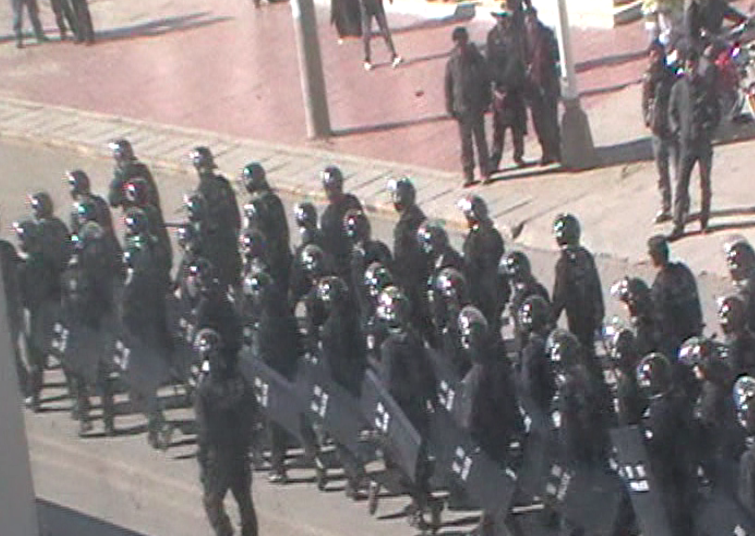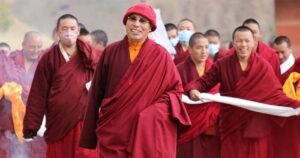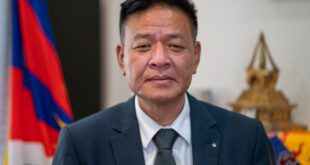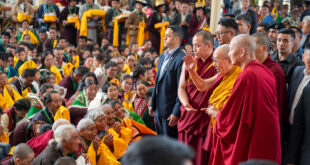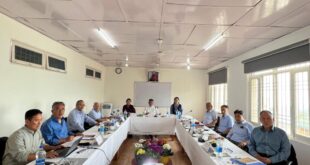By TOM LASSETER | McClatchy Newspapers |Tuesday, Feb. 14, 2012
ABA (Ngaba), China– The monk reached into the folds of his red robe, pulled out a small notebook, and gently slipped from its pages a tiny photograph.
The man in the creased picture was a relative. He used to be a fellow monk at the monastery perched in snow-wrapped mountains outside the town ofAba. Then a Chinese security officer killed him, the monk said.
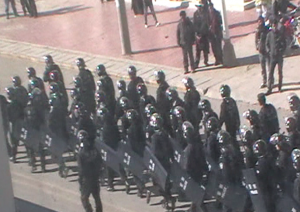
It is a sorrow that cannot be spoken of in public. A local government “working team” visits the monastery often, looking for signs of discontent, according to monks there. Sometimes, they said, when returning to their living quarters from chanting or studying, the monks find a door busted in and possessions scattered after a search.
The monk showed the snapshot as a way of explaining why ethnic Tibetans, mostly current or former Buddhist clergy, are setting themselves on fire in Aba and surrounding regions in an unprecedented show of protest against Chinese rule. Since March 2011, between 20 and 24 have committed self-immolations, according to rights groups. Of those, at least 13 are said to have died.
“China in our eyes is not fair or peaceful,” said the monk, a man in his early 40s who, like every ethnic Tibetan interviewed for this story, did so on the condition that he not be named and that certain details be withheld, for fear of getting dragged off by police. “We are suffering a lot in our hearts, and when we can no longer bear it we burn ourselves to death.”
The Chinese government and its media have confirmed some of the self-immolations and denied others. But the government also goes to extensive lengths to prevent outsiders from visiting this area. Police routinely block roads, search vehicles and turn back foreigners, especially journalists.
A McClatchy Newspapers reporter last week became the first from an American news organization to make it toAbasince the chain of self-immolations began. To do so, he hid on the rear floor of a vehicle under two backpacks and a sleeping bag as it passed through multiple checkpoints.
Beijing has long blamed unrest in ethnic Tibetan areas on conspiracies hatched by the Dalai Lama, the Tibetan spiritual leader who fled to India after a failed uprising against Chinese rule in 1959.
But conversations with ethnic Tibetans here and elsewhere in Sichuan province, where almost all of the self-immolations have occurred, suggest that China’s authoritarian policies designed to tamp down disorder are fueling the troubles.
As the nation’s vice president and presumptive next leader, Xi Jinping, tours the United States this week amid talk of greater understanding, his government at home continues to flood a wide swath of ethnic Tibetan lands with armed troops.
At the entrance to Aba last week, at least seven police officers manned a checkpoint. When an SUV approached with a Han Chinese man in the front seat, it was allowed to pass without a question – as the McClatchy Newspapers reporter lay in the back.
Ethnic Tibetans face tougher scrutiny. One Tibetan from a nearby village described the interior of his taxi being almost ripped apart during a search at the entry of Aba, which is known in Tibetan as Ngaba.
About the same time the reporter entered Aba on Saturday, an 18-year-old woman in a nunnery near the town’s outskirts was setting herself on fire. The ethnic Tibetan nun, Tenzin Choedon, reportedly called out slogans against the government as the flames took her life.
Sections of the town famous for its Tibetan Buddhist monasteries have come to resemble an armed camp. A few blocks from the entrance, paramilitary police stood behind riot gates with shotguns and assault rifles. Three large troop-carrier trucks sat on the side of the road, flanked by more men with guns. Up ahead, traffic wound through further riot gates and troop positions not unlike those used in counterinsurgency efforts.
The security was so dense that it was impossible to speak with clergy or, indeed, anyone in Aba because of the risk of bringing danger to those interviewed. The Internet had been shut off and efforts to send text messages fromAbafailed repeatedly.
Police roadblocks and patrols in the region begin just outside the city of Chengdu, hundreds of miles away. Even in that sprawling metropolis,Chengdu’s main Tibetan quarter is stacked with police who stand guard outside restaurants and shops that sell incense and religious paraphernalia.
An attempt in November to reach Aba ended with a McClatchy reporter being held and questioned by Chinese police for two hours before he was released and told to return to Beijing.
Aba, in the high mountains and mist, gained international attention as an epicenter of Tibetan turmoil last March when a monk from the Kirti monastery lit himself ablaze. He was reportedly commemorating the third anniversary of 2008 demonstrations and riots across the Tibetan Plateau, includingAba, which ended in bloodshed.
After that self-immolation, some 300 other monks were allegedly hauled away from Kirti in trucks, sparking concern from the United Nations.
Chinese officials point out that they have spent billions of dollars constructing hospitals, roads and schools inTibet, which is referred to byBeijingas an autonomous region, and nearby areas like those inSichuan.
Or as a billboard depicting green fields and blue waters outside Maierma Township, approximately 20 miles from Aba, puts it: “Building a civilized, new Aba together.”
Many ethnic Tibetans recognize the benefits of the government’s projects. But they chafe at the government’s restrictions on free expression of their culture and religious practices, and they speak of anguish over being separated from the Dalai Lama.
The lingering threat of police showing up at their doorstep has by all accounts made the situation even more complicated for ethnic Tibetans.
“If you say the government is not treating us well, that’s not completely true, they are providing us with good things,” said a 26-year-old small-time trader in Hongyuan, which sits 65 miles or more to the east of Aba, depending on which winding road is taken. “But on the other side, the police are behaving badly. We don’t know what to say about the situation.”
The man, in a brown leather coat and sunglasses pushed up his forehead, thought it over and then said, “You should talk with somebody inAba.”
His younger brother, sitting in the family’s living room under a single light bulb, spoke up: “Of course things are not good, they are killing people.”
The brothers turned to their father, a man in his late 40s who had a green camouflage jacket slung over his shoulders and a cigarette in hand.
Why were Tibetans self-immolating?
The father first wanted it made clear that he would not “take legal responsibility” for his words, and then said, “The Chinese government issues messages that these things are happening because of foreign plots, but of course the people lighting themselves on fire are local people … ”
The father paused and looked at the small stove in front of him, which was heating the room with burning stacks of yak dung.
The younger brother, in his early 20s and with plans to move to a bigger city, finished the sentence with an assertion that no one contradicted.
“The people lighting themselves on fire do it because they are suffering … or because one of their family members has been killed by the government and they are now filled with hatred,” he said. “They are doing these things because they want to express their pain and their hardship.”
The majority of Tibetans approached in the area said they couldn’t discuss such issues.
One herder near the town of Chali, about 30 miles east of Aba, gestured for a reporter to follow him to his house. Once inside, the 67-year-old man with tough, thick hands shook his head, saying, “I’m sorry, I’m sorry, I don’t dare talk about this.”
Walking back out across a field, the herder in brown corduroy pants and a dark winter jacket had a piece of advice: Listen to what the monks have to say.
The monk with the dead relative had marched in a demonstration against the Chinese government during the tumult of March 2008. When the police later came, the monk said, they surrounded the monastery and threatened to destroy it if those who had participated in the incident didn’t turn themselves in.
Official documents describing his arrest said that he and others had taken part in an action that “disrupted public order” and caused a traffic jam. The monk keeps the papers tucked in a plastic bag even though they are written in Mandarin, a language he doesn’t understand well.
The monk said he was held in jail and fed such small amounts of thin porridge that it became difficult to stand up. He was then transferred to a reform-through-labor camp. “They told me that the Dalai Lama group is an obstacle to our road to peace,” said the monk, who was reluctant to describe the nearly two-year experience.
His relative never made it back – he died in custody, the result of being beaten in the head and then not receiving medical treatment, according to the monk and others at the monastery.
The monk returned to the area nearAbain 2010. Much was as he left it. Candles made of yak-butter still flicker in the night. Old men patiently twirl prayer wheels. Young monks with freshly shaven heads scamper up and down steep hillsides.
The monk found that one of his framed pictures of the Dalai Lama had survived in a hiding spot. The glass was cracked and missing a piece, but the rainbow-colored frame and the image itself were intact.
With the ongoing government searches and his record of jail time, having the photograph around could be hazardous for the monk.
He kept it anyway.
